As an Amazon Associate KitchenwareSets.com earns from qualifying purchases.
11 Cozy Japanese Kitchen Design Ideas For Small Spaces
Is your small kitchen feeling more chaotic than calm? Do you find yourself battling clutter on every countertop and struggling to find a moment of peace in one of the most important rooms in your home? It’s a common frustration. A cramped, disorganized kitchen can make cooking feel like a chore rather than a joy, adding unnecessary stress to your daily routine. You dream of a space that’s not just functional, but also a serene retreat.
What if you could transform that small, stressful space into an oasis of tranquility and efficiency? Drawing on years of analyzing interior design trends, we’ve seen how the principles of Japanese aesthetics consistently solve the biggest challenges of small-space living. The secret lies in blending Japanese minimalism with Scandinavian warmth, a style known as “Japandi.” It’s the perfect, achievable solution to create a kitchen that feels both open and incredibly cozy.
A cozy Japanese kitchen blends minimalism with warmth by using natural materials, earthy colors, and smart storage. This design philosophy, often called Japandi, transforms small spaces into serene, functional, and inviting environments perfect for modern living. This guide will walk you through 11 actionable ideas to help you achieve this beautiful and practical transformation.
Is Your Small Kitchen Feeling More Chaotic Than Calm?
The common frustration with small kitchens is that they often feel cramped, cluttered, and stressful instead of serene and functional. This happens when every surface is covered and storage is inefficient, turning the heart of the home into a source of anxiety. The solution is to adopt a design philosophy that prioritizes both minimalism and warmth.
What Makes a Kitchen “Japandi”?
Japandi is a design hybrid blending Japanese minimalism with Scandinavian warmth. It emphasizes simplicity, natural materials like wood and stone, neutral color palettes, and high functionality to create spaces that are simultaneously clean, cozy, and calming. This style is built on several core principles:
- Focus on Craftsmanship: Valuing well-made items that are built to last.
- Love for Natural Materials: Prioritizing wood, stone, linen, and ceramic to bring the outdoors in.
- Emphasis on Functionality: Ensuring every element has a purpose, eliminating unnecessary clutter.
- Beauty in Imperfection: Embracing the Japanese concept of wabi-sabi (finding beauty in imperfection) and the Scandinavian feeling of hygge (coziness and contentment).
11 Cozy Japanese Kitchen Ideas to Transform Your Small Space (Updated for 2025)
Ready to turn your compact kitchen into a cozy and functional masterpiece? These 11 visually inspiring and practical ideas are curated from successful real-world small kitchen renovations and the core principles of Japanese and Scandinavian design. They can be adapted to any budget or skill level, helping you create a kitchen that is both beautiful and highly efficient.
1. Embrace Earthy, Warm Color Palettes
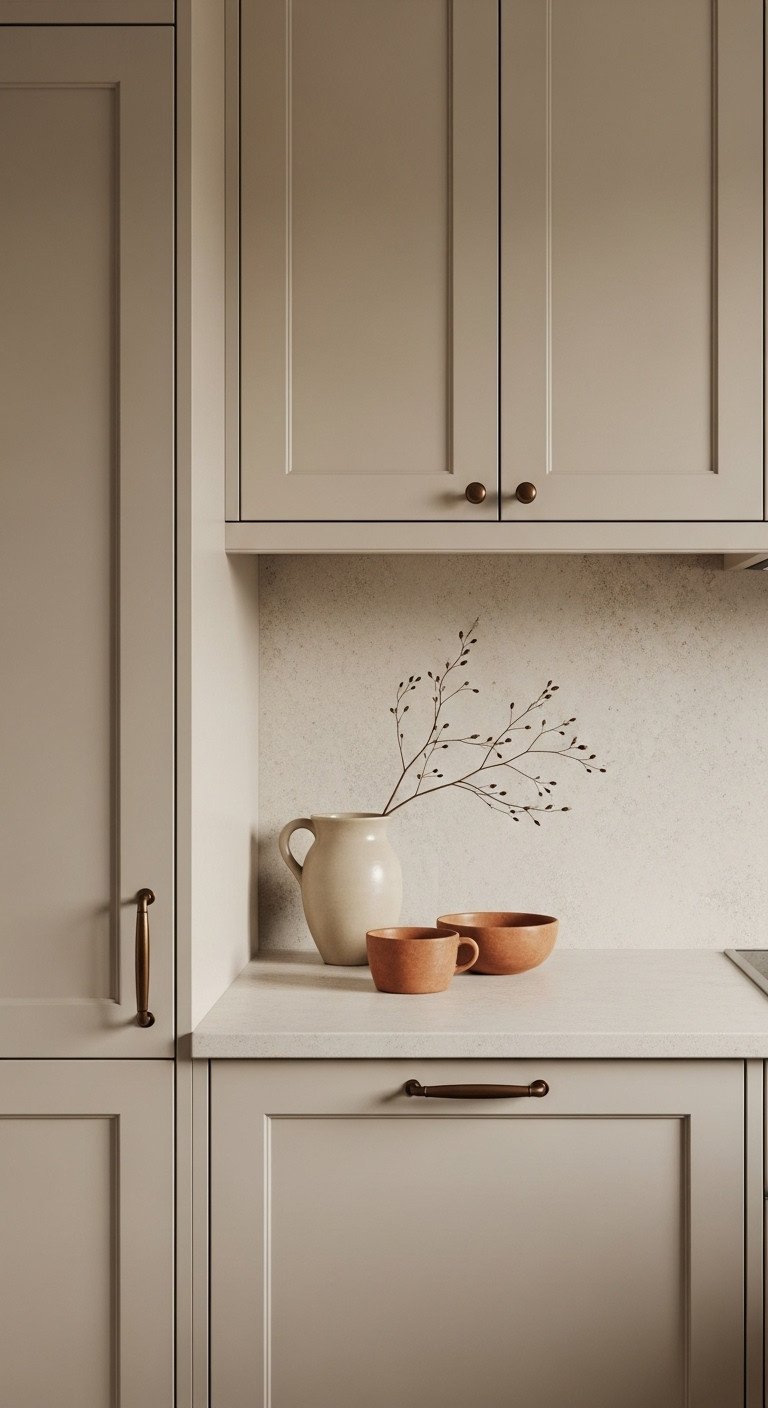
Save this calming color palette to your ‘Kitchen Inspiration’ board!
The foundation of a cozy Japanese kitchen is a calm, nature-inspired color palette. Move away from stark whites and instead choose soft, warm neutrals that create a serene and inviting atmosphere.
- Materials Needed: High-quality cabinet paint (satin or matte finish), painter’s tape, fine-grit sandpaper, primer, paint rollers/brushes.
- Step-by-Step Directions:
- Choose a palette of 2-3 soft neutrals like beige, taupe, or warm gray.
- Thoroughly clean and lightly sand your cabinet doors to ensure proper paint adhesion.
- Apply a coat of high-adhesion primer, which is crucial for a durable finish in a high-traffic kitchen.
- Apply two thin coats of your chosen cabinet paint, allowing ample drying time between coats. Opt for a high-quality, durable kitchen cabinet paint for longevity.
- Pair the freshly painted cabinets with light countertops or a simple tile backsplash to complete the look.
Pro-Tip: Always test paint swatches in your kitchen at different times of the day. Natural light can dramatically change how a color appears.
2. Utilize Open Shelving for Visual Lightness
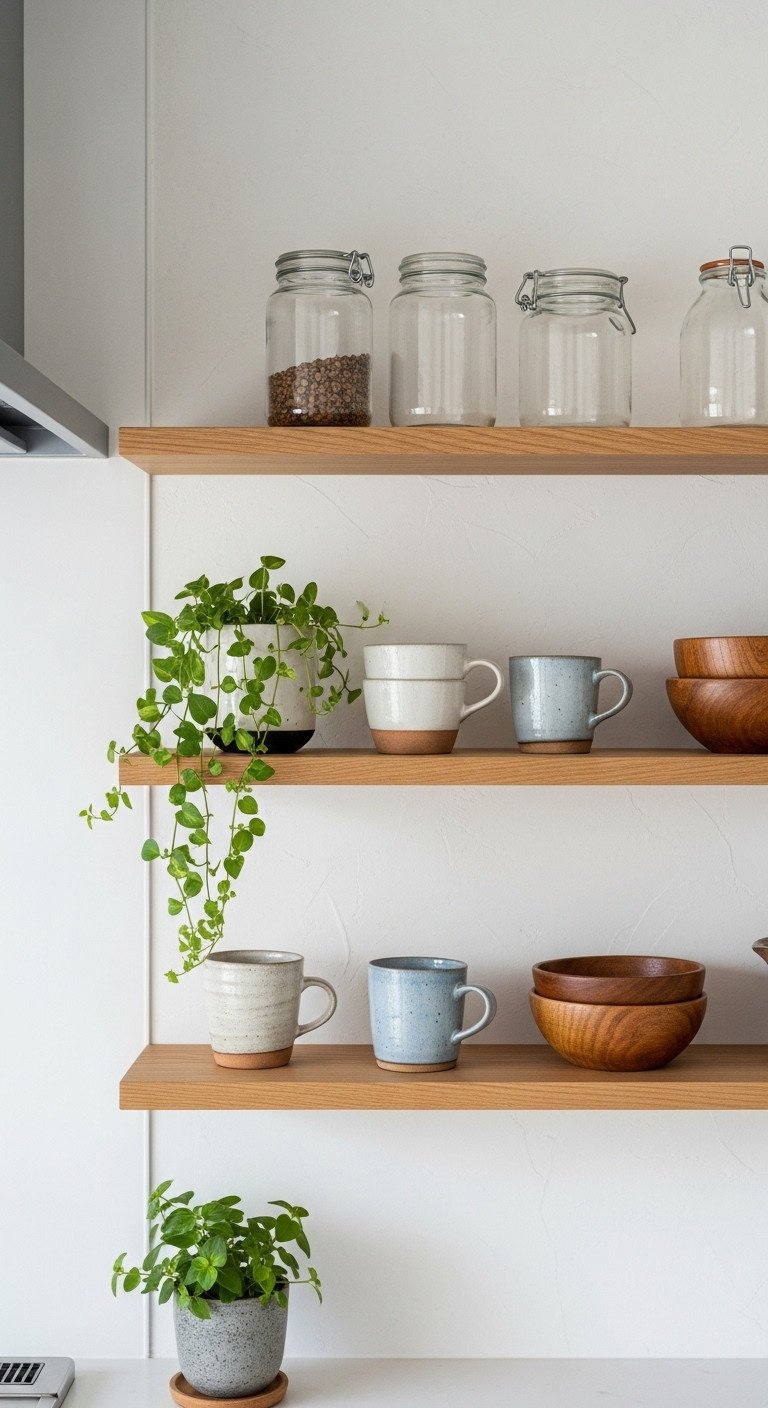
Pin this beautiful shelf styling idea for later!
Bulky upper cabinets can make a small kitchen feel top-heavy and enclosed. Replacing them with open floating shelves creates a sense of airiness and space. This allows you to display beautiful, functional items while making the room feel larger.
- Materials Needed: Natural wood floating shelves, heavy-duty wall anchors, stud finder, level, drill.
- Step-by-Step Directions:
- Identify a section of wall where you can replace bulky upper cabinets or add new storage.
- Use a stud finder to locate wall studs for the most secure installation. If studs aren’t available, use appropriate heavy-duty drywall anchors.
- Choose sturdy, natural wood floating shelves with a simple design. The thickness of the shelf should feel substantial but not bulky.
- Use a level to mark your drill holes and mount the shelf brackets or internal hardware.
- Style the shelves with a “less is more” approach. Display your most beautiful and frequently used items like ceramic bowls, mugs, and a small plant.
Lesson Learned: Avoid overcrowding open shelves. The goal is to create visual breathing room, not just transfer clutter from a cabinet to the wall.
3. Incorporate Handcrafted Accessories
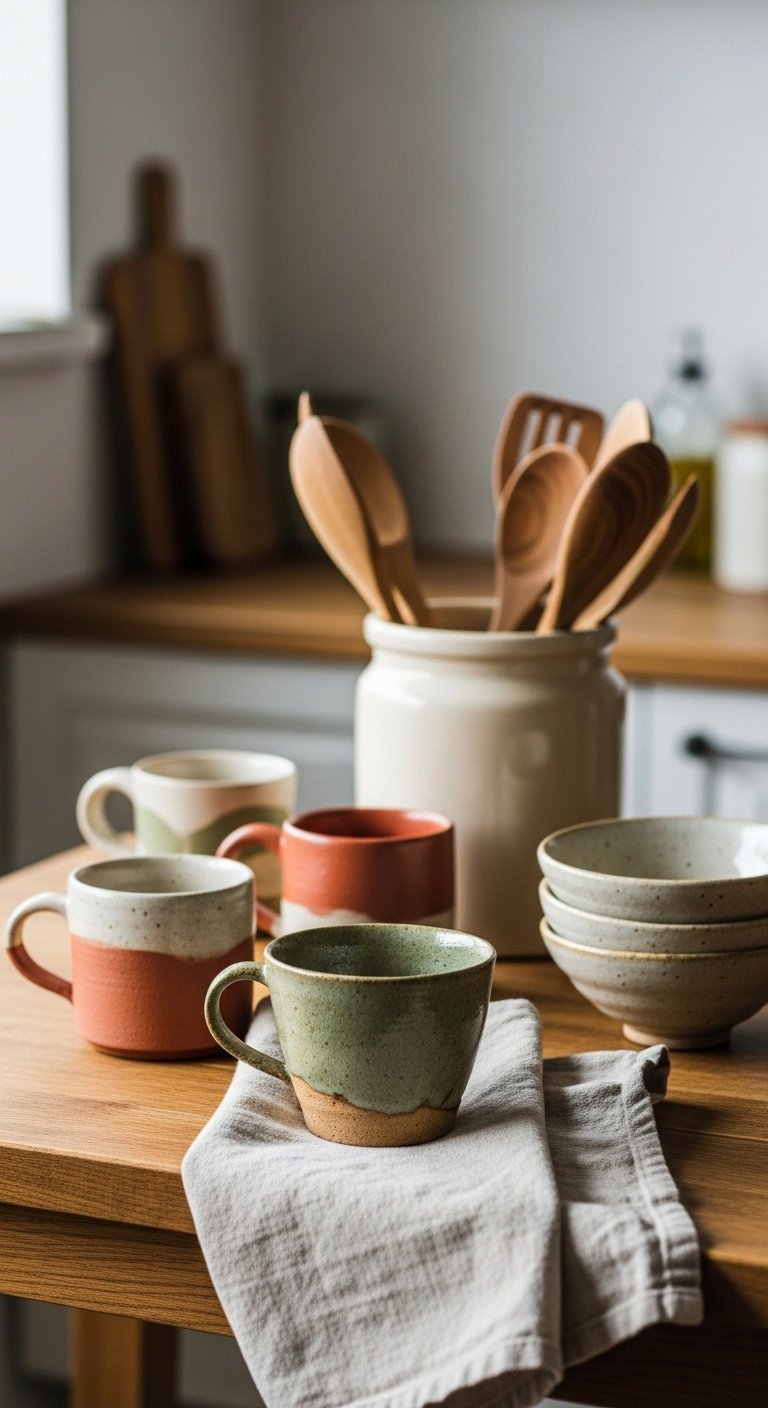
Love this wabi-sabi vibe? Save it to your ‘Home Details’ board!
The soul of Japandi design lies in wabi-sabi, the appreciation of imperfection. Add character and warmth by choosing unique, handcrafted items over mass-produced ones. These pieces tell a story and bring a human touch to a minimalist space.
- Materials Needed: Curated selection of handcrafted items.
- Step-by-Step Directions:
- Start small. Replace generic, mass-produced items with unique, handcrafted alternatives one at a time.
- Look for items where you can see the maker’s touch, like a slightly irregular ceramic mug or a hand-carved wooden spoon. High-quality handmade ceramic mugs are a perfect starting point.
- Incorporate natural textiles. Swap paper towels for a set of beautiful linen or soft cotton tea towels.
- Display these items thoughtfully on open shelves or countertops, treating them as functional art.
Pro-Tip: Visit local craft fairs or online artisan marketplaces to find truly unique pieces. Supporting small artists adds an extra layer of meaning to your decor.
4. Choose Natural Wood Cabinets for Warmth
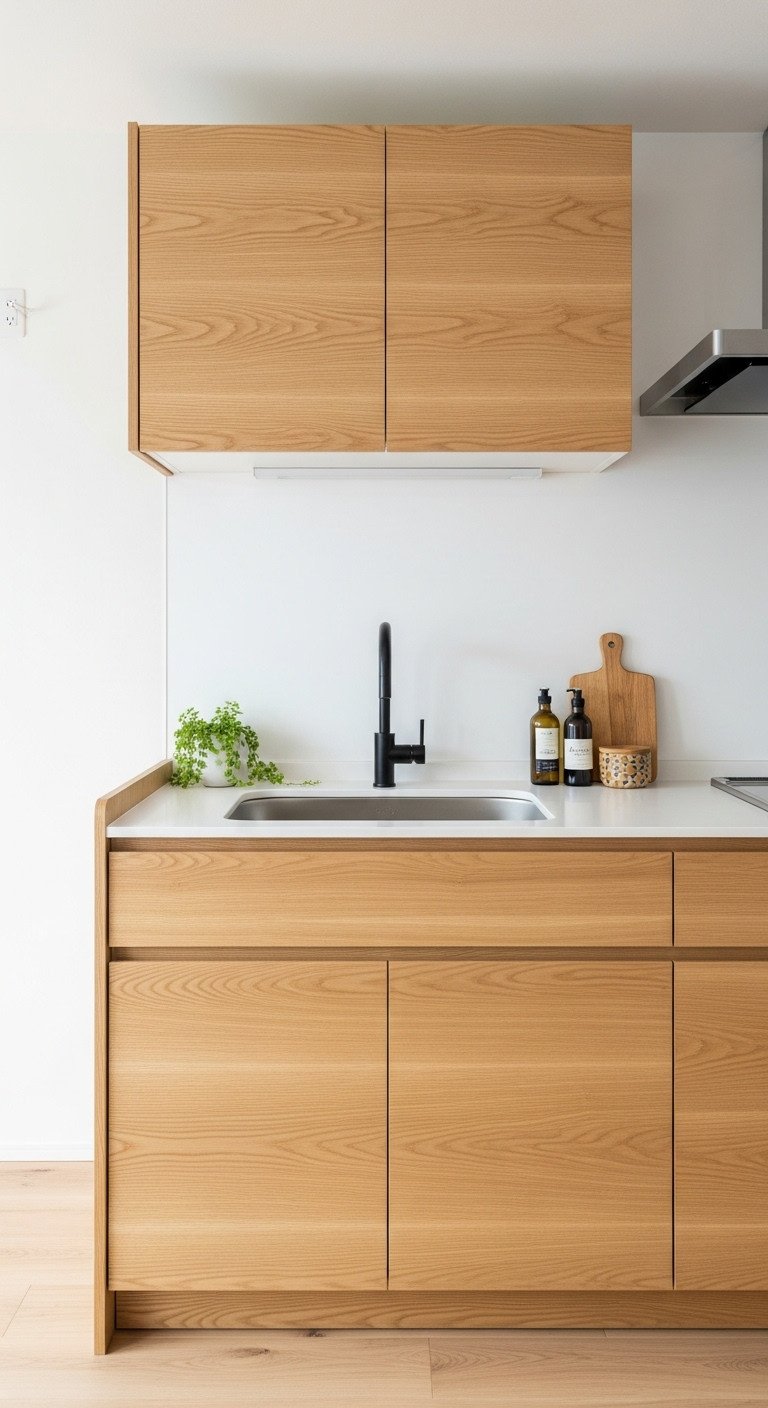
Dreaming of wood cabinets? Pin this for your future reno!
Wood is the cornerstone of Japandi design, instantly adding organic warmth and texture to the kitchen. Opt for light-colored woods with a visible, soft grain to keep the space feeling bright and open.
- Materials Needed: (For existing cabinets) Wood cleaner/conditioner, microfiber cloths.
- Step-by-Step Directions:
- If renovating, opt for flat-panel or shaker-style cabinets in a light wood like white oak or ash to maximize the sense of space.
- Look for finishes that celebrate the natural grain rather than hiding it under a heavy stain.
- For a budget-friendly update, you can reface existing cabinets with a real wood veneer.
- If you already have wood cabinets, give them a deep clean and conditioning. Use a high-quality natural wood cabinet cleaner to remove grease and bring back their natural luster. This simple step can make them look brand new.
Pro-Tip: Light woods like oak and maple make a small kitchen feel larger and more airy, while darker woods like walnut can add a touch of sophisticated drama, especially when balanced with light countertops and walls.
5. Use Stone Surfaces to Ground the Space
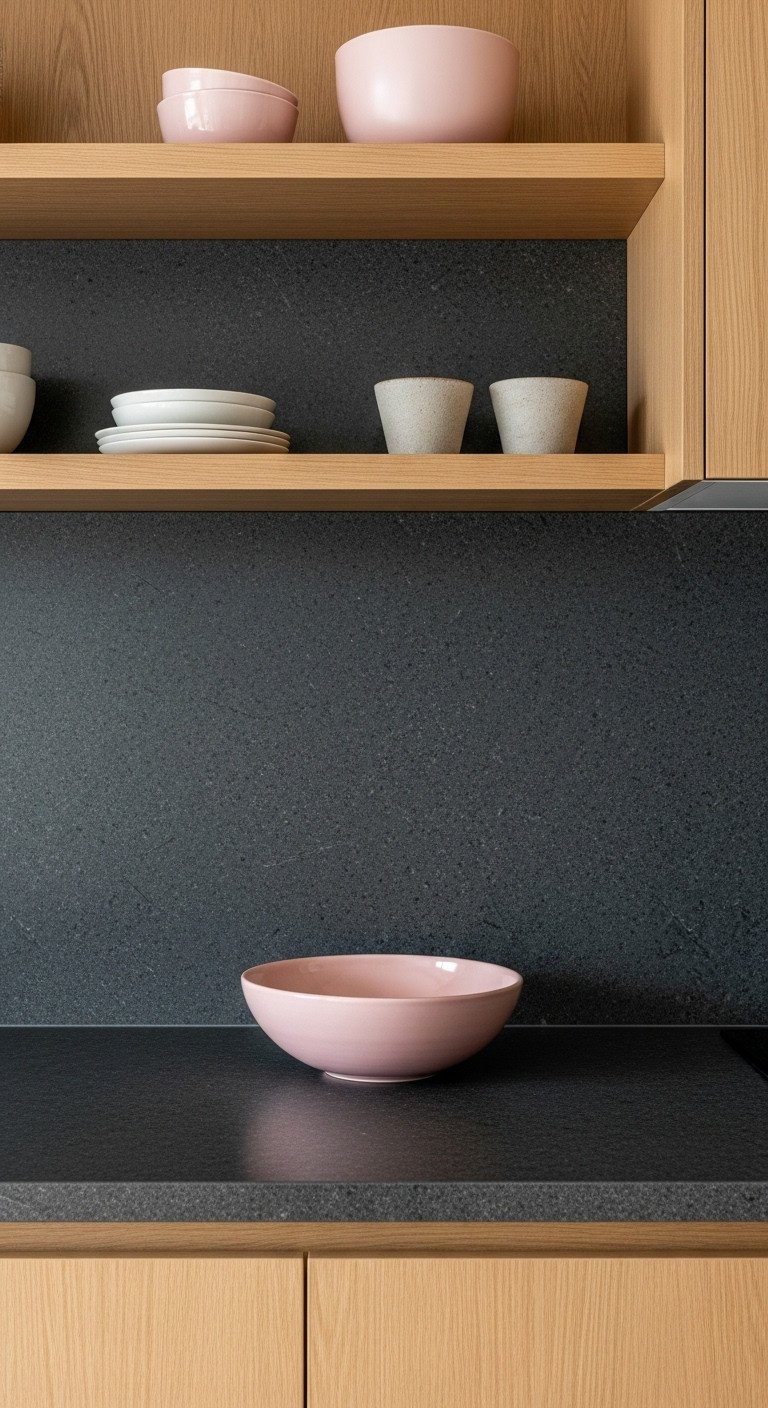
Add some drama to your kitchen! Save this stone backsplash idea.
To balance the warmth of wood, incorporate the cool, solid feel of natural stone. This adds tactile contrast and a grounding element to the design. A matte finish is key to maintaining the soft, non-reflective aesthetic.
- Materials Needed: Peel-and-stick stone-look backsplash tiles, utility knife, level, measuring tape.
- Step-by-Step Directions:
- Choose stone with a matte or honed finish over a polished one to align with the natural, non-reflective Japandi aesthetic.
- For a major impact, consider a durable material like quartz or soapstone for countertops.
- For a budget-friendly and DIY-friendly alternative, create a stunning backsplash using high-quality stone look peel and stick backsplash tiles. These offer the texture and color of real stone without the need for grout or professional installation.
- Measure your backsplash area carefully, clean the wall, and apply the tiles using a level to ensure a straight application.
Lesson Learned: A dark stone backsplash behind light wood cabinets is a classic Japandi move that creates instant depth and sophistication without overwhelming a small space.
6. Illuminate with Japandi Pendant Lights
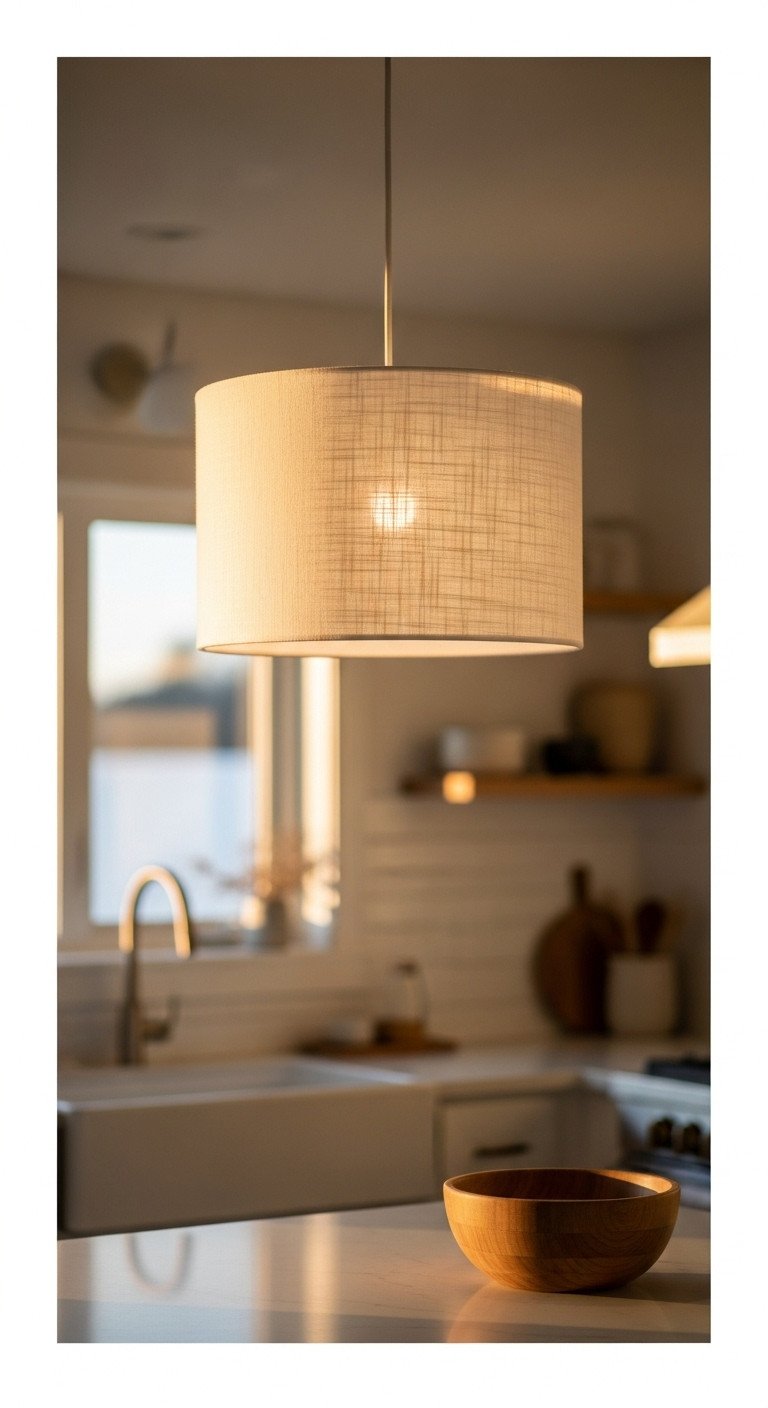
Pin this perfect pendant light for a cozy glow!
Lighting is crucial for creating a cozy atmosphere. Choose pendant lights made from natural materials that cast a soft, warm, diffused glow. Avoid harsh, direct lighting in favor of fixtures that act as sculptural, calming elements.
- Materials Needed: Pendant light kit, chosen lampshade (rice paper, linen, etc.), ceiling box, basic electrical tools.
- Step-by-Step Directions:
- Choose a pendant with a simple silhouette and a shade made from natural materials. A classic choice is an authentic rice paper pendant light fixture, which provides a beautiful, diffused glow.
- Hang the pendant light over a key area, such as a small dining nook or a peninsula, to create a focal point and an intimate zone.
- Ensure the bottom of the pendant hangs about 30-36 inches above the surface to provide effective light without obstructing views.
- Use a warm-toned LED bulb (2700K is ideal) to enhance the cozy atmosphere.
Pro-Tip: If you can’t hardwire a new light, use a plug-in pendant kit with a ceiling hook for an easy, renter-friendly installation.
7. Refresh and Soften with Fresh Plants
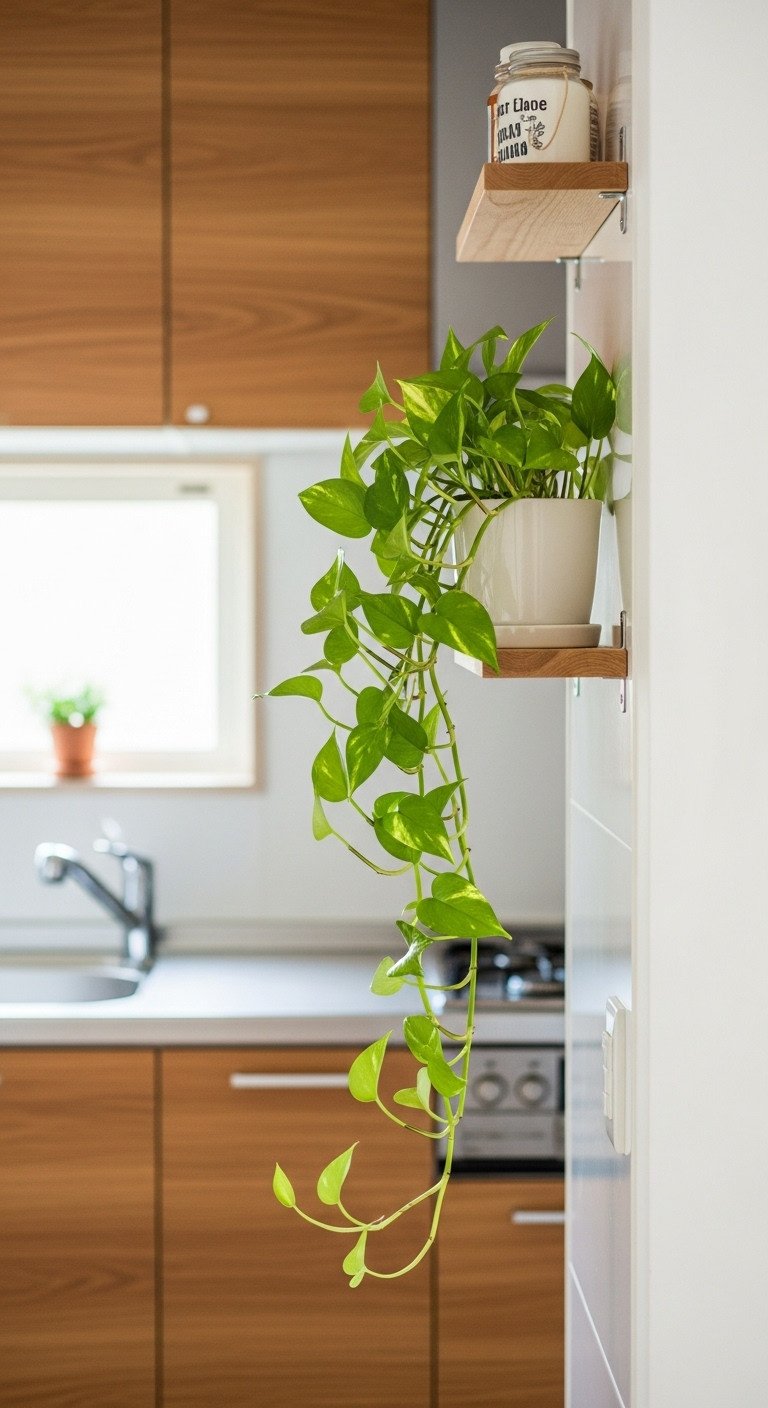
Bring your kitchen to life! Save this plant styling tip.
A touch of green is essential for any nature-inspired design. Plants add life, color, and a sense of calm, softening the hard lines of cabinets and countertops and literally bringing the outdoors in.
- Materials Needed: Low-maintenance plants, simple pots, potting soil.
- Step-by-Step Directions:
- Choose plants that thrive in typical kitchen conditions (variable light and humidity). Pothos, snake plants, and ZZ plants are excellent, hardy choices.
- Select planters that complement your Japandi aesthetic. Simple, elegant ceramic planters for indoor plants in neutral colors or earthy terracotta are perfect.
- Place plants strategically to soften hard lines. A trailing plant like a pothos on top of a cabinet or a taller plant in an empty corner works well.
- A small pot of fresh herbs on the windowsill is both beautiful and functional.
Lesson Learned: One or two well-placed, healthy plants will have a much greater impact than several small, struggling ones. Focus on quality over quantity.
8. Introduce Soft, Minimalist Kitchen Furniture
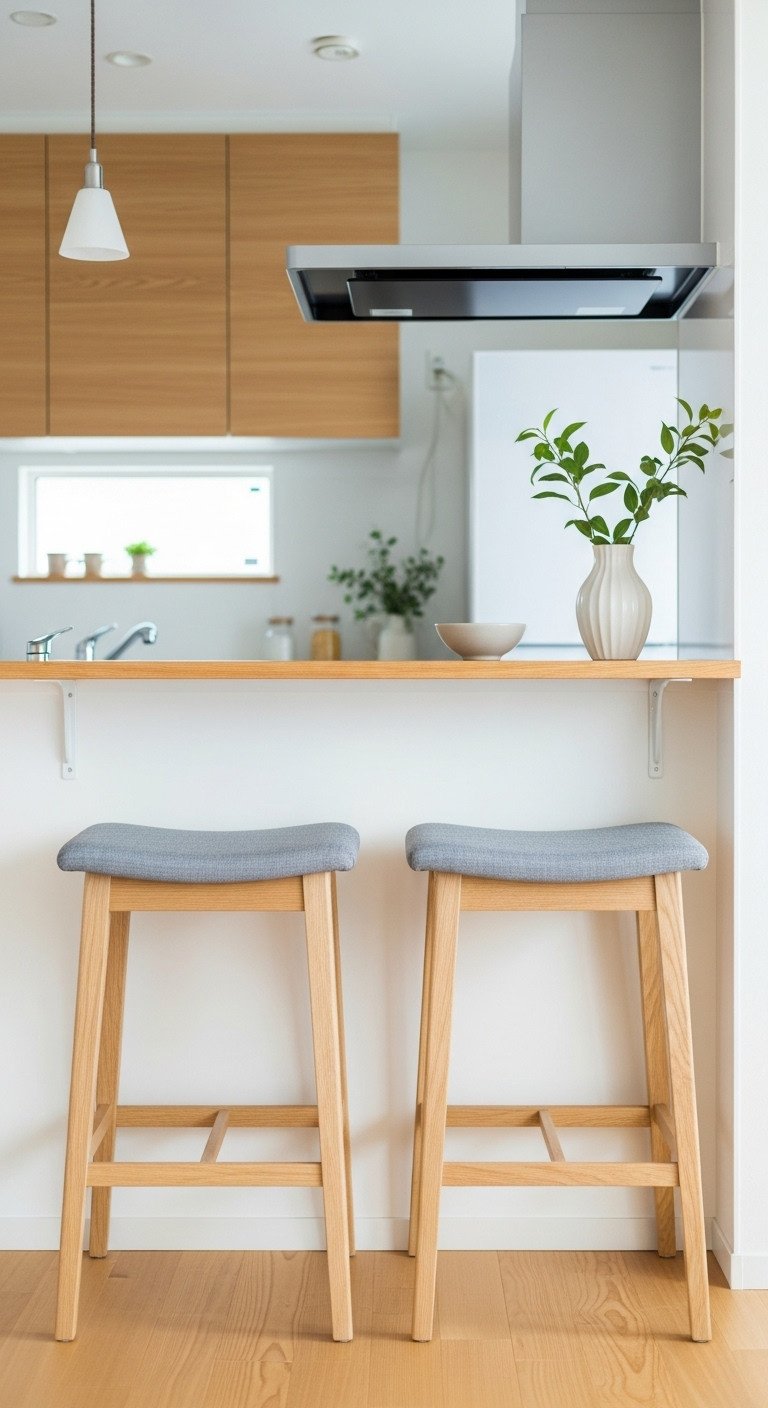
Simple and stylish. Pin these perfect kitchen stools!
Furniture in a Japandi kitchen should be both beautifully simple and highly functional. Look for pieces with clean lines, natural materials, and an unobtrusive design that complements the space without overwhelming it.
- Materials Needed: Minimalist stools or chairs.
- Step-by-Step Directions:
- Look for furniture with clean lines, simple forms, and a focus on the natural material.
- For a small eating area or island, choose backless stools that can be tucked completely under the counter to save space when not in use. A set of natural wood counter stools is a perfect choice.
- Ensure the furniture is as functional as it is beautiful. Comfort is key, even in a minimalist design.
- Avoid pieces with ornate details, heavy ornamentation, or bright, jarring colors.
Pro-Tip: Measure carefully! Ensure your stools are the correct height for your counter (counter-height is typically 24-26 inches, bar-height is 28-30 inches).
9. Balance Light and Dark Elements for Depth
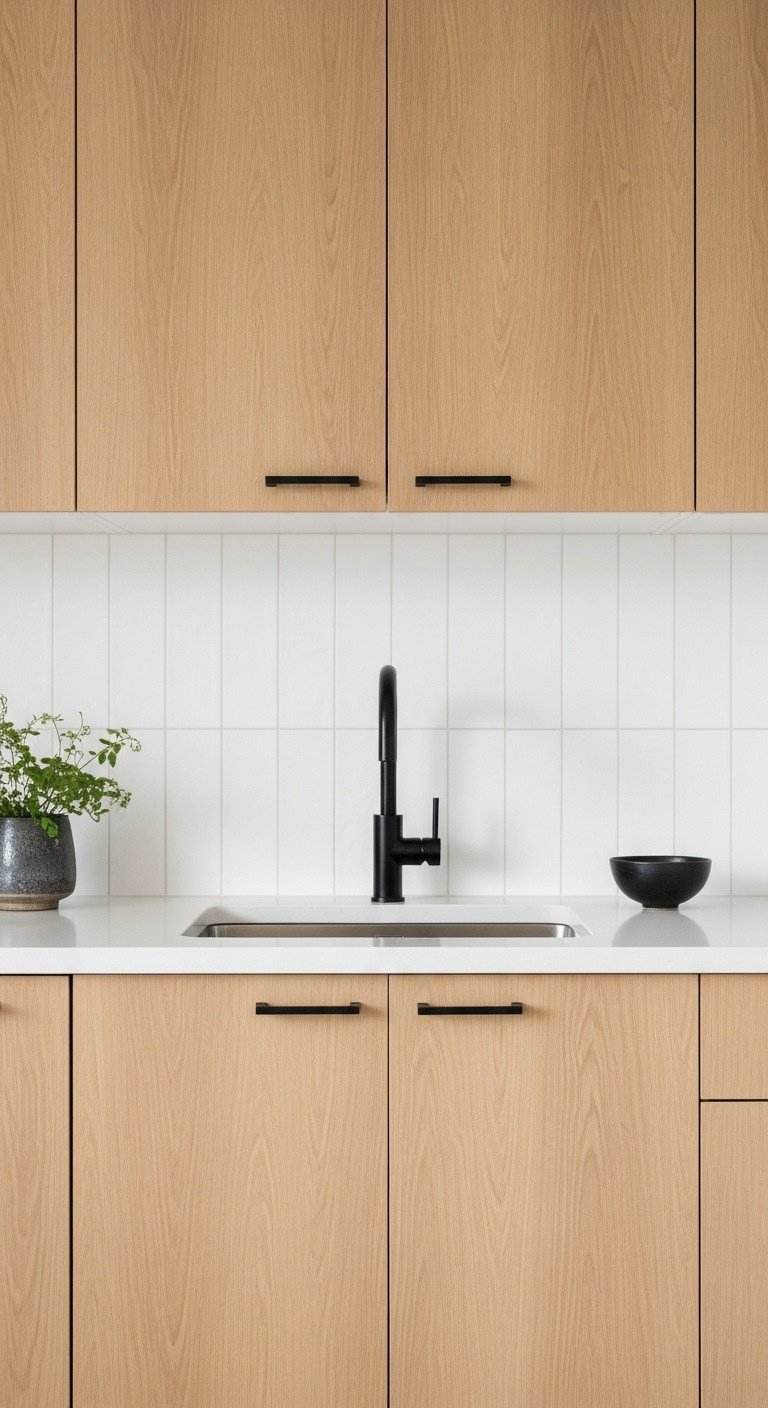
Save this high-contrast look for a sophisticated kitchen!
A purely neutral space can sometimes feel flat. Introduce small, deliberate touches of black or charcoal gray to create contrast, depth, and a touch of modern sophistication. The key is to use dark elements as accents, not dominant features.
- Materials Needed: New cabinet hardware, screwdriver, drill (if holes need to be changed).
- Step-by-Step Directions:
- The easiest way to introduce contrast is by swapping out your cabinet hardware.
- Unscrew your existing knobs and pulls. Measure the distance between the screw holes for pulls.
- Choose new hardware that creates a distinct contrast. On light wood or white cabinets, simple, elegant matte black cabinet pulls provide a striking and modern update.
- Install the new hardware, ensuring all pieces are level and secure.
- Consider matching your faucet or a pendant light to the new hardware color for a cohesive look.
Lesson Learned: A little contrast goes a long way. Start with small touches like hardware or a dark picture frame before committing to a larger element like a dark backsplash.
10. Layer Natural Textures for Coziness
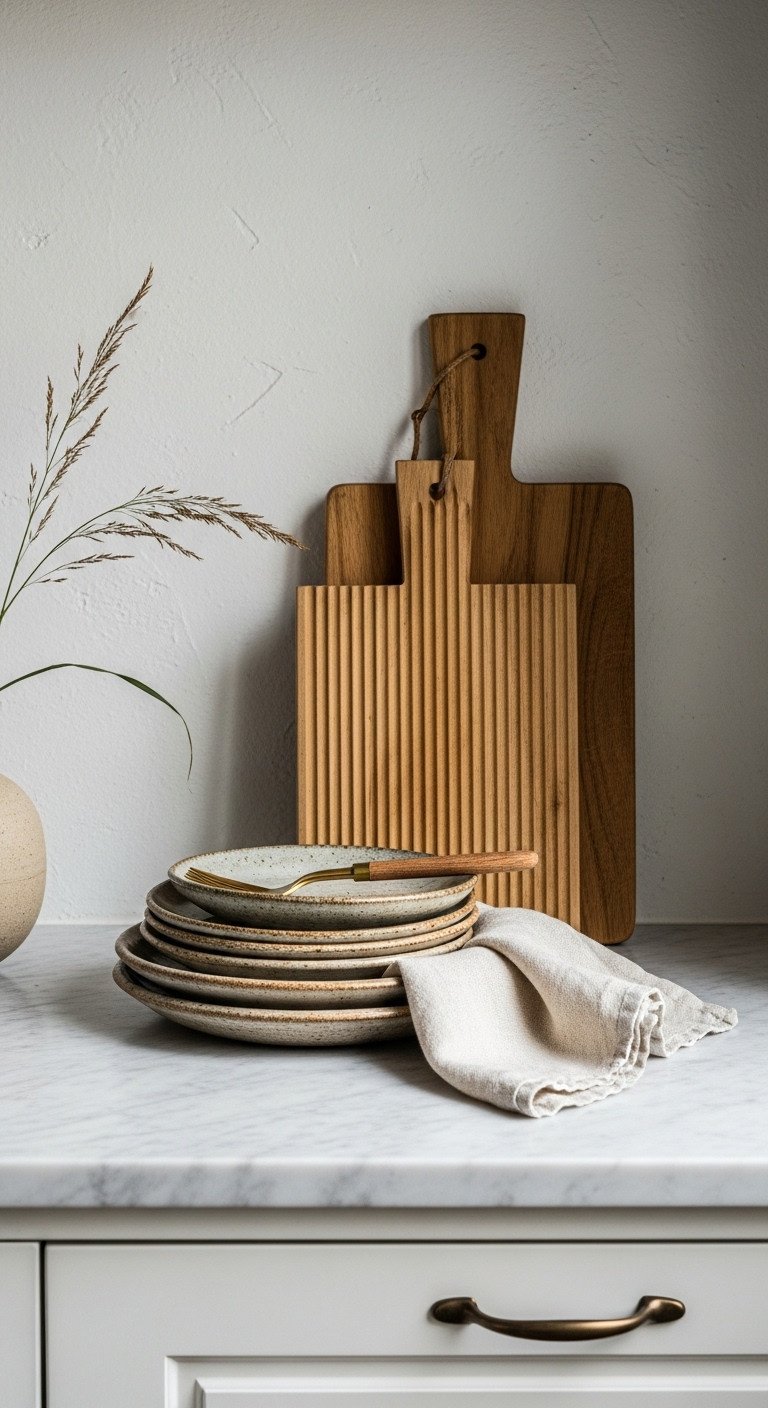
Feel the texture! Pin this cozy detail for your kitchen.
To prevent a minimalist kitchen from feeling cold or sterile, you must layer different natural textures. This adds visual interest and a tactile sense of comfort that is central to the feeling of hygge.
- Materials Needed: Textured decor items like runners, placemats, cutting boards, etc.
- Step-by-Step Directions:
- Think about how different materials feel to the touch. Aim to mix smooth with rough, and soft with hard.
- Place a woven linen table runner across a small kitchen island or table. This simple addition adds immediate softness and texture.
- Lean a wooden cutting board with a visible grain against your backsplash.
- Use earthenware mugs with a slightly rough, matte finish.
- Consider adding a small, low-pile wool rug in front of the sink for comfort underfoot.
Pro-Tip: Fluted or reeded textures on wood paneling, cabinet fronts, or even glassware are very popular in Japandi design and add subtle, linear texture.
11. Maximize Space with Hidden Storage
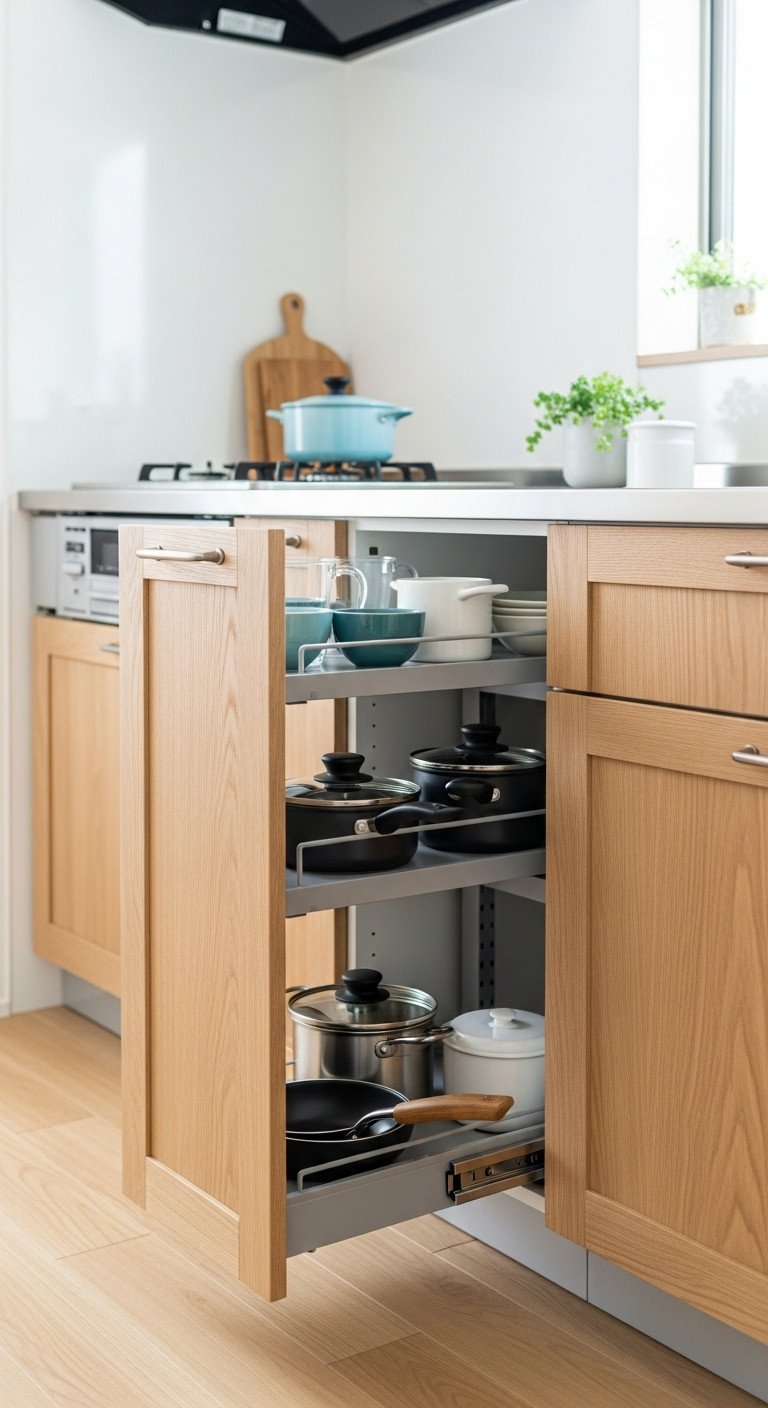
Get organized! Save this genius small space storage solution.
The ultimate key to a serene kitchen is an uncluttered countertop. Achieve this by investing in smart, hidden storage solutions that make the most of every square inch inside your cabinets. An organized interior allows for a minimalist exterior.
- Materials Needed: Pull-out cabinet organizer, drill, measuring tape, screwdriver.
- Step-by-Step Directions:
- The key to a serene Japanese kitchen is decluttered countertops. Prioritize getting as much as possible behind closed doors.
- Measure the interior of your deep base cabinets, especially the awkward ones under the sink or in corners.
- Install a pull out cabinet organizer. These sliding shelves make it easy to access everything stored in the back of the cabinet, effectively doubling your usable space for pots, pans, or cleaning supplies.
- Use drawer dividers for utensils and cutlery, and consider a vertical storage rack for baking sheets and cutting boards.
Lesson Learned: Before buying any organizer, empty the cabinet and decide what really needs to go back in. This is the perfect opportunity to declutter items you never use.
Key Takeaways: Your Quick Guide to a Cozy Japanese Kitchen
- Embrace Nature: Prioritize natural materials like light wood, stone, and linen. Incorporate plants to add life and softness.
- Warm Neutral Palette: Stick to earthy colors like beige, taupe, and warm grays to create a serene and timeless backdrop.
- Function First: Maximize every inch with smart, hidden storage to keep countertops clear. Every item should have a purpose and a place.
- Layer for Coziness: Mix different textures (smooth stone, rough ceramics, soft textiles) and use warm, diffused lighting to prevent minimalism from feeling cold.
- Focus on Simplicity: Choose items with clean lines, from cabinets to furniture. Value craftsmanship and imperfection (wabi-sabi) over clutter.
People Also Ask About Cozy Japanese Kitchen
How can I make my small Japanese kitchen feel cozy, not cold?
To make a minimalist Japanese kitchen feel cozy, focus on layering textures and warm lighting. Incorporate soft linen towels, rough-hewn ceramics, and a natural wood cutting board. Use pendant lights with paper or fabric shades to cast a soft, warm glow. These elements add tactile and visual warmth without creating clutter, perfectly balancing minimalism with comfort.
What is the main difference between Japanese and Japandi kitchen design?
A traditional Japanese kitchen design strictly follows principles of minimalism, nature, and simplicity. Japandi design is a hybrid that blends these Japanese elements with Scandinavian warmth and comfort (known as “hygge”). Japandi often incorporates more soft textiles, cozier furniture, and a slightly warmer, more layered feel while maintaining the clean, functional base of Japanese aesthetics.
What are the best colors for a small Japandi kitchen?
The best colors are warm, earthy neutrals that reflect nature and make the space feel larger. Opt for shades like soft beige, taupe, mushroom gray, ivory, and cream. You can use a darker color, like charcoal or deep brown, as a small accent on hardware or a backsplash to add depth, but the overall palette should remain light and airy.
Final Thoughts
Creating a cozy Japanese kitchen in a small space isn’t about having less; it’s about making what you have more meaningful and functional. By blending the simplicity of Japanese design with the warmth of Scandinavian style, you can craft a kitchen that is not just a place to cook, but a peaceful retreat from the chaos of daily life. What’s the first step you’re excited to take to bring a little more calm to your kitchen? Let us know in the comments below
Last update on 2025-10-14 at 23:05 / Affiliate links / Images from Amazon Product Advertising API
